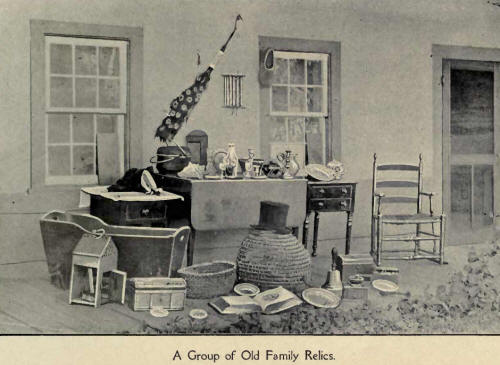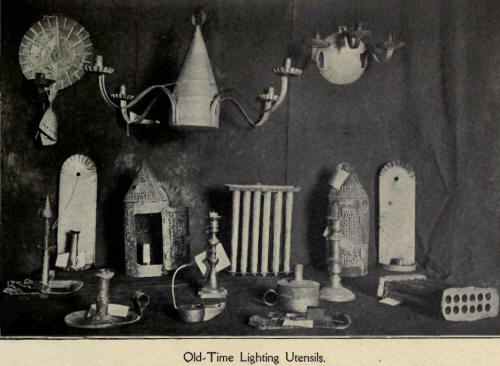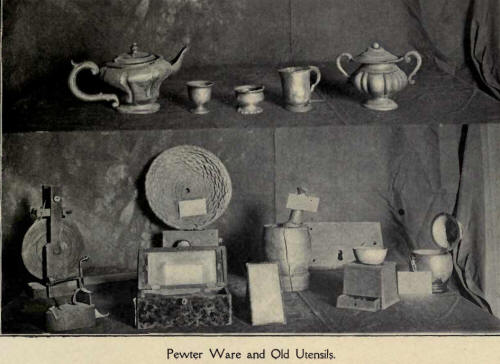|
EARLY HOUSEHOLD UTENSILS AND ARTICLES OF FURNITURE— PEWTER AND CROCKERY
WARE—CANDLES AND CANDLESTICKS —TEA AND COFFEE, AND THEIR
SUBSTITUTES—LIGHTING THE FIRE.
MANY of the
household utensils in use
from fifty to one hundred years ago
were very rude and plain, compared
the machine-made articles in use at the
present day. We will describe a few of the more common. Perhaps the rudest
of the household utensils was the old-fashioned splint broom, corn-top
brooms not being in use three-quarters of a century ago. It was sometimes
called the Indian broom, as it was, n doubt, first used by the Indians.
They made them and peddled them around among the people. Many of the early
settlers made such brooms themselves, fine ones being made for sweeping
the house and coarser ones for scrubbing and for use around the barn and
stables. Sometimes a bunch of blue beech twigs or hemlock boughs, tied
together at the end of a stick, was made to serve as a kitchen broom.
The splint broom was made in the following manner: A
stick of green wood, usually hickory, birch or blue beech, one and a half
or two inches in diameter, was first selected. After the bark had been
removed the stick was splintered up for eight or ten inches with a sharp
knife, commencing at the bottom, until enough splints had been made to
form the centre of the broom, the part of that end of the stick remaining
being cut off. The stick was then splintered for a certain distance from
above, the splints being bent over so that they covered and reached to the
bottom of the first lot of splints. The whole were then bound into a round
bundle forming the broom, the part of the stick remaining, after being
shaved down to the proper thickness, serving as a handle. When corn-top
brooms came into use many of the farmers made their own, a patch of broom
corn being raised for this purpose.
Gourds were hollowed out and used for dipping water,
soft soap, etc., as tinware was then more expensive than it is now. For
dusting off the hearth the wing of a fowl, usually that of a turkey or
goose, was used. When not in use it hung on a nail beside the
fireplace.

The old wooden boot-jack was always handy for the
farmer to pull off his long cowhide boots after coming in from his work.
It was to be seen hanging in a convenient place. A common chair was the
old-fashioned home-made splint-bottomed chair. Sometimes the bottom
was made of strands of elm or willow-bark, and again of rushes. Like all
the old furniture, though plain, it was strong and made to last.
In the sleeping apartments of the family was to be
seen the old family bedstead, with a high wooden framework on top enclosed
by damask curtains, and with a white linen curtain or valance around the
bottom of the bedstead, as well as the low trundle-bed, on wooden castors
or rollers, in which the children of the family slept in the same room
with their parents, often until they were twelve or fourteen years of age,
and which in the daytime was shoved underneath the large bed. When the
farmer was short of bedroom space there was to be seen in the dining-room
or kitchen the old- fashioned bunk, which served as a seat or bench in the
day-time and a bed at night, the lower part being in the shape of a box,
which, when opened up, disclosed a quantity of bedclothing, and made a
comfortable place for sleeping. Among the more fashionable articles of
furniture were the big high bureau, the two-drawer stand, and the
fall-leaf table. Nor must the important cheese-tub be omitted from this
category. Our grandmothers used it for making cheese, and also the dye-tub
for dying cloth or yarn. For cooking in the fire-place there was the
long-handled frying-pan, the long-handled skimmer and long-handled ladle.
The handles of these utensils were made three or four feet in length, so
that the cook could stand away from the heat of the
fire. A rest usually stood in front of the fire-place for placing the
handle on when the cook happened to be busy with other work.
Many kept a fire-box, with handle
attached, for carrying live coals from one room to another when making a
fire before the days of matches. In some houses was to be seen the warming
pan, with cover and long handle. It was not connected with cooking
operations, as many might suppose from its shape, but was filled with live
coals and passed underneath the bed-clothes to warm them up on cold winter
nights.
For making pancakes they had a
griddle with an iron bail made fast to it for hanging it to the crane. The
waffle irons also deserve mention. They were filled with batter and buried
in the coals. They also had toasters for setting before the fire.
Pewter and Crockeryware.
In the early days, china,
porcelain and glassware being very expensive, as all articles of that
character had to be imported from the Old Country, pewter and crockeryware
were quite common among the people. Occasionally there might be seen a few
pieces of china, as, for instance, a sugar bowl, cream pitcher, or teapot,
ornamenting the mantel, which were kept as cherished heirlooms in the
family, and perhaps were owned by some great-grandmother who lived in the
colonial times of New England, or belonged to some remote ancestor in the
Old Country, who lived 150 or 200 years before.
Fifty and seventy-five years ago,
even, there was not nearly as much porcelain ware to be seen among the
common people as now, many of the dishes, cups and spoons being made of
pewter. Although most of the farmers had a set of earthenware dishes, yet,
for fear they should get broken, many of them supplied their children with
pewter cups and plates; and if we went far enough back to the scant days
of the early pioneer times, when dishes of any kind were still scarce, we
might occasionally see some of the children all eating out of the same
dish of soup or porridge set up in the centre of the table, and no doubt,
it tasted just as good as if each one had had a portion in a separate
bowl. Milk and water pitchers and the six-penny and shilling (York) crocks
for holding the milk were made of crockery ware. A few horn spoons were to
be seen, especially among the Scotch settlers, who used them for their
porridge. Spoons and plates made of. wood were also hi-ought into
requisition. Pewter ware was not easily broken, and was, therefore, the
most economical kind to use. If the hunter happened to be out of bullets
he would often take the broken spoons, etc., melt them in an iron vessel
and pour them into the bullet moulds.
Candles and Candlesticks.
We can scarcely realize that it is little more than
fifty years since coal gas was introduced, coal oil * within the last half
a century, and incandescent and electric lights within the last
twenty-five years. Before the introduction of coal oil lamps the common
method of lighting was by tallow candles, Dutch lamps, the tallow dip, and
pine knots, and many an ambitious youth in those days read and studied by
no other light than that obtained from the burning logs in the fire-place.
Although the candle does not give the amount of light that is to be
obtained from coal oil, gas, or electricity, the old settlers loved its
flickering, mellow light, and even after the introduction of modern
methods of lighting, many of them continued to prefer the use of candles.
Candles were made in tin moulds. The cotton wick was stretched through the
mould, tied in a knot at the pointed end, and attached to a stick at the
large end. The mould was then filled with melted tallow and set away for
the tallow to cool and harden, after which the candles were drawn out and
put away in the candle-box for future use.
The candlesticks for holding the candles were of all
kinds and sizes, from the most expensive silver, brass, china and crystal,
down to the ordinary tin candlestick, with the bottom
in the form of a tray for holding the snuffers and burnt matches. The
snuffers were a specially-prepared kind of scissors for cutting off the
charred part of the wick, so that the candle would burn brighter. The
extinguisher was a small, cone-shaped article, attached to the candlestick
by a chain, and used for placing over the flame of the candle when you
wished to extinguish it. Dutch lamps were flat, urn-shaped vessels made of
iron, brass and copper. They were filled with lard oil, the wick
protruding from the side by a nose. A chain attached, with a hook to it,
was used for hanging the lamp up. The hook was also used for drawing out
the wick when it burned low. This lamp was introduced into the country by
the Dutch and German settlers.
The tallow-dip was made by
twisting strands of cotton twine, attaching a number of them to a stick
and dipping them into melted tallow, repeating the operation as soon as
the tallow had hardened, until proper-sized candles were obtained. After
the introduction of the tin mould for making candles this operation was
discarded by most people.
For use around the barn and
stables there was the old-fashioned tin lantern, without any glass, but
perforated with holes for the light to shine through, and with a tallow
candle inside. After this came the lanterns with glass sides. Many of the
old settlers soaked the rush tops in oil and used them for lighting
purposes.
The "Witch" was made by putting a coil of cotton rag
into a saucer of tallow or other grease, the burning end being allowed to
hang over the edge of the saucer. In the public halls and churches, to
light up the assemblages, there were the "sconces," i.e., candlesticks
made of tin for hanging to a nail in the wall, the high back of the sconce
serving as a reflector, besides a candlestick or two sitting on the pulpit
or desk for the speaker to see by. These lighting arrangements showed up
the room very dimly compared to our present brilliant means of lighting by
gas and electricity. Frequently people, and generally at the
singing-schools, took their own candles with them to see to sing and read
by. These were truly old-fashioned times, but their simplicity and spirit
of industry made them all the more enjoyable. When we pause for a moment
to picture to ourselves our grandfathers and grandmothers moving around in
the hazy light of the tallow candle and the fire-place, we are impelled to
exclaim, "Truly, what great changes the past century has wrought!"
Tea and Coffee and Their Substitutes.

Such luxuries as tea and coffee were much more
expensive in the early times than they are now, on account of the greater
cost of carriage and the heavy duties then imposed upon them. Our
economical forefathers, however, knew how to adjust themselves to
circumstances, and when they could not afford the genuine article they
always had something to take its place. As a substitute for tea they used
decoctions of such herbs and barks as sage, thyme, chocolate root, spice
wood, hemlock boughs and sassafras, and for coffee they roasted peas and
barley, acorns and dandelion roots, rye and carrots, or they toasted bread
and made a decoction of the crust. When the genuine coffee became cheaper,
its use was quite common among the people generally, only that they bought
it green and roasted and ground it themselves. The familiar sound of the
coffee-mill, as the housewife ground up the roasted bean previous to
preparing the favorite breakfast beverage, as well as the aroma from the
kitchen that followed it, were intimations to the tardy riser that it was
time to get up. The original hand coffee-mill was round or square, and
made of iron or wood. Later on came the kind that was fastened by screws
to the mantel over the fire-place or the window- jamb. These hand
coffee-mills were sometimes used for grinding wheat for porridge, as well
as pepper and other spices for seasoning purposes.
Lighting the Fire.
Lucifer or friction matches are a
comparatively recent invention. It is not much more than fifty years since
Congrieve brought out his self-lighting or phosphorus-tipped match. The
first matches of this kind were made in blocks, and were so imperfect that
it was some years after their invention, however, before their use became
general. In the early days, and well on into the middle of the nineteenth
century, fire was got by means of the flint and tinder-box. When fire was
so difficult to obtain people were very careful not to let their fires go
out, and it was no uncommon sight to see persons going a mile or two
through the snow to their nearest neighbor's to get a few coals to start
the fire on a cold winter's morning. It was the custom to cover up the bed
of coals with ashes at night before retiring, so that there would be some
left with which to start the fire in the morning, all that was necessary
being to add kindling wood and blow the embers into a flame with the hand
bellows.
The following amusing incident is
told by a descendant of one of the old pioneers: One morning, the fire on
the hearth having gone out, one of the daughters cut up a handful of
cotton cloth and placed it in the fireplace, while one of the sons loaded
the gun with a wadding of cotton and discharged it into the bundle of
rags, so as to set them on fire. The father of the family, who was still
sleeping, was awakened by the report of the gun, and came hurriedly
downstairs, thinking something terrible had happened, but was well
contented when he found a blazing fire the result.
When matches were first introduced
they were not, as now, tipped with phosphorus, but were simply pieces of
stick dipped in melted sulphur. These sulphur sticks, or matches, as they
were called, were lighted by placing them in contact with live coals or
the flame of a candle.
When we stop to consider, we have
reason to be startled by the fact that we now enjoy so many privileges and
means of comfort that were unknown fifty years ago even. We are led to
conclude that the past century has seen more progress than any previous
century of which we have any record in the world's history.
The tinder-box was a tin box with
a tight-fitting cover, used for making and preserving the tinder, which
was made by holding finely-cut cotton or linen rags over the uncovered
box, setting them on fire and, after they were all in a blaze, allowing
them to drop into the box beneath, then replacing the cover and smothering
the fire. The charred remains formed the tinder. To get a light all that
was necessary was to strike the flint and steel together over the opened
box, so that the sparks would fall into it and ignite the tinder, after
which it was touched with a sulphur stick and the fire applied to the
kindling-wood in the fire-place. This was the English way.
Among most of the early settlers
punk—a fungus growth in decaying wood, thoroughly dried—frequently took
the place of the tinder. The flints they used were often Indian
arrow-heads, which were found in many places when ploughing. By placing a
piece of punk on the flint, held in the left hand, and striking the flint
with a piece of steel (usually the back of the-steel blade of a
pocket-knife ) held in the right hand; the sparks would fly on to the punk
and ignite it, after which it was placed in the fire-place, kindling-wood
added and blown into a flame.
Some used the old flint-lock gun
for starting a fire Some such combustible material as tow or linen cloth
cut fine was placed in the flash pan of the gun. The trigger being pulled,
sparks would fly into the pan and cause ignition. Once, when an uncle of
the writer was getting fire in this way, the gun happened to be loaded.
The steel ramrod, which was in the gun at the time, was driven into the
board ceiling of the room, where it was allowed to remain for some time as
a reminder of the incident.

These were slow and tedious ways
of obtaining fire, but they were the only means known (with the exception
of the sun glass) to our grandfathers.
|

